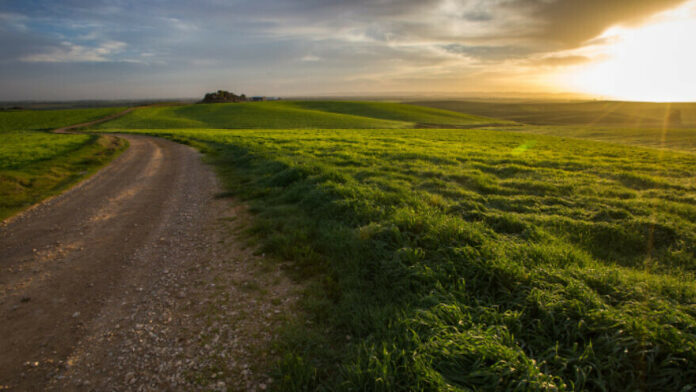
JERUSALEM (JNS) – The word “Negev” conjures up visions of miles of desert, sand dunes, barren landscapes, camels, and yes, the meme that “Israel made the desert bloom.”
Join our WhatsApp groupSubscribe to our Daily Roundup Email
But traveling through the northwestern portion of that 4,650-square-mile desert today presents quite a different picture. A recent trip to the “Gaza envelope” and Eshkol region of the Negev proved that the area is not only blooming but thriving as an incubator for some of Israel’s most cutting-edge social, educational and technical developments.
Since the Eshkol region shares borders with both Egypt and the Gaza Strip, many of the projects are designed to support the residents of communities that have been on the frontline of Hamas and Palestinian Islamic Jihad attacks for decades.
One of the most striking and innovative initiatives is the GrooveTech Center, located just two miles from the Gaza border on a campus together with schools that educate 2,500 students. The reinforced two-story building is the largest technology center in Israel.
A big source of diversion and pride came last December when the launch of NASA’s James Webb Telescope was broadcast from GrooveTech. The NASA collaboration came about through an high-ranking Israeli-born NASA scientist who was a consultant in the creation of GrooveTech’s space center.
According to GrooveTech Center Director Maydan Peleg, the community had originally asked JNF-USA for funds to help build a jungle gym. “They said, ‘Nope, you need to dream bigger,’ and this is the result,” she adds with a smile.
“Kids who come here can forget the outside; they can feel pride and accomplishment and get absorbed in cutting-edge, exciting activities that help keep them strong,” she continued. “They can be exposed to the highest levels of tech, and they can dream to be whatever they want.”

“The place is a game changer,” Carey-Lee Tal, a South Africa-born Eshkol community activist, tells visitors. Tal explains that GrooveTech not only helps keep kids in the area but also acts as an economic catalyst, providing jobs for local residents.
GrooveTech means that high school kids interested in any field of technology or engineering don’t need to travel to Tel Aviv or Beersheva for enrichment. “They can get what they need right here,” she said.

A few miles away, less than half a mile from the border with Egypt, Yedidia Harush welcomes visitors to the fully sustainable dairy farm that belongs to the community of Halutza.
Harush, whose white shirt, black kippah and visible tzitzit ritual fringes would look more at home in a Jerusalem yeshiva than in the middle of a cowshed, is proud to show off what he calls “the Halutza happy cows.”
He relates how he and his family arrived in Halutza after they were evicted from their homes in Gush Katif in 2005, when Israel unilaterally left the Gaza Strip.
Despite the pain and anger over the destruction of their communities, Harush says his family and others who went to Halutza decided to “take the positive side and contribute to the development of the Negev.”
Over the last 17 years, in cooperation with JNF-USA, Harush said roads had been paved and hundreds of greenhouses erected, and that more than 85 species of fruits and vegetables are now grown in the area. Fields of solar energy panels have also been established, he said.

But his pride and joy is the cowshed, which opened 10 months ago and is fully robotic, enabling the operation to be fully Shabbat observant.
Grazing space for dairy cows is very limited all over the country and the Negev’s sandy landscape and hot climate are not conducive to the practice, but there is plenty of land available in the Halutza area, so Harush’s cows each enjoy 22 square meters (about 236 square feet) of living space.
Unlike in most dairy farms, the 450 Halutza cows eat on demand and deliver up 41 liters per day of milk—far above the 28-liter average of other Israeli cowsheds.
“It’s an economic anchor for the communities,” Harush explained. “JNF-USA’s contribution is not purely philanthropic. Twenty-eight percent of the income from the milk is reinvested in Negev projects,” he noted.
Before letting visitors leave the area, Harush insists on showing us another pioneering agritech initiative not far from the dairy farm.
Opening the canvas door to a space that contains row upon row of thriving, seven-foot-tall greenery, Harush explained why his community is growing modified tobacco.

The leaves are picked and sent to a processing facility in Yesud HaMa’ala in the Hula Valley in northern Israel, where they’re crushed and liquidated. Thirty-five tons of leaves make seven liters of highly purified recombinant collagen, he explained. This material is then turned into a hydrogel for 3D bioprinting of tissues and organs, including lungs and kidneys. There’s far less chance of rejection or infection from this form of collagen than from that extracted from animals or human cadavers, said Harush.
With a scarcity of organ donors around the world, the process that’s started from plants grown in the sands of a startup community in the Negev has the potential to save many lives.
It’s the 2022 version of “making the desert bloom.”
